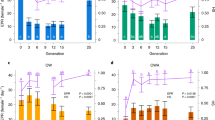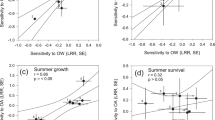Abstract
Phytoplankton photosynthesis is a critical flux in the carbon cycle, accounting for approximately 40% of the carbon dioxide fixed globally on an annual basis and fuelling the productivity of aquatic food webs. However, rapid evolutionary responses of phytoplankton to warming remain largely unexplored, particularly outside the laboratory, where multiple selection pressures can modify adaptation to environmental change. Here, we use a decade-long experiment in outdoor mesocosms to investigate mechanisms of adaptation to warming (+4 °C above ambient temperature) in the green alga Chlamydomonas reinhardtii, in naturally assembled communities. Isolates from warmed mesocosms had higher optimal growth temperatures than their counterparts from ambient treatments. Consequently, warm-adapted isolates were stronger competitors at elevated temperature and experienced a decline in competitive fitness in ambient conditions, indicating adaptation to local thermal regimes. Higher competitive fitness in the warmed isolates was linked to greater photosynthetic capacity and reduced susceptibility to photoinhibition. These findings suggest that adaptive responses to warming in phytoplankton could help to mitigate projected declines in aquatic net primary production by increasing rates of cellular net photosynthesis.
This is a preview of subscription content, access via your institution
Access options
Access Nature and 54 other Nature Portfolio journals
Get Nature+, our best-value online-access subscription
$29.99 / 30 days
cancel any time
Subscribe to this journal
Receive 12 digital issues and online access to articles
$119.00 per year
only $9.92 per issue
Buy this article
- Purchase on Springer Link
- Instant access to full article PDF
Prices may be subject to local taxes which are calculated during checkout





Similar content being viewed by others
References
Falkowski, P. G. Biogeochemical controls and feedbacks on ocean primary production. Science 281, 200–206 (1998).
Raven, J. A. & Falkowski, P. G. Oceanic sinks for atmospheric CO2 . Plant Cell Environ. 22, 741–755 (1999).
Field, C. B. Primary production of the biosphere: integrating terrestrial and oceanic components. Science 281, 237–240 (1998).
Falkowski, P. G. The role of phytoplankton photosynthesis in global biogeochemical cycles. Photosynth. Res. 39, 235–258 (1994).
Bopp, L. et al. Potential impact of climate change on marine export production. Glob. Biogeochem. Cycles 15, 81–99 (2001).
López-Urrutia, Á., Martin, E. S., Harris, R. P. & Irigoien, X. Scaling the metabolic balance of the oceans. Proc. Natl Acad. Sci. USA 103, 8739–8744 (2006).
Laufkötter, C. et al. Drivers and uncertainties of future global marine primary production in marine ecosystem models. Biogeosciences 12, 6955–6984 (2015).
Regaudie-de-Gioux, A. & Duarte, C. M. Compensation irradiance for planktonic community metabolism in the ocean. Glob. Biogeochem. Cycles 24, GB4013 (2010).
Schluter, L. et al. Adaptation of a globally important coccolithophore to ocean warming and acidification. Nat. Clim. Change 4, 1024–1030 (2014).
Padfield, D., Yvon-Durocher, G., Buckling, A., Jennings, S. & Yvon-Durocher, G. Rapid evolution of metabolic traits explains thermal adaptation in phytoplankton. Ecol. Lett. 19, 133–142 (2015).
Listmann, L., LeRoch, M., Schluter, L., Thomas, M. K. & Reusch, T. B. H. Swift thermal reaction norm evolution in a key marine phytoplankton species. Evol. Appl. 9, 1156–1164 (2016).
Raven, J. A. & Geider, R. J. Temperature and algal growth. New Phytol. 110, 441–461 (1988).
Lawrence, D., Bell, T. & Barraclough, T. G. The effect of immigration on the adaptation of microbial communities to warming. Am. Nat. 187, 236–248 (2016).
Lawrence, D. et al. Species interactions alter evolutionary responses to a novel environment. PLoS Biol. 10, e1001330 (2012).
Collins, S. Competition limits adaptation and productivity in a photosynthetic alga at elevated CO2 . Proc. R. Soc. B 278, 247–255 (2010).
Yvon-Durocher, G., Jones, J. I., Trimmer, M., Woodward, G. & Montoya, J. M. Warming alters the metabolic balance of ecosystems. Phil. Trans. R. Soc. B 365, 2117–2126 (2010).
Yvon-Durocher, G. et al. Five years of experimental warming increases the biodiversity and productivity of phytoplankton. PLoS Biol. 13, e1002324 (2015).
Geider, R. J., MacIntyre, H. L. & Kana, T. M. Dynamic model of phytoplankton growth and acclimation: responses of the balanced growth rate and the chlorophyll a:carbon ratio to light, nutrient-limitation and temperature. Mar. Ecol. Prog. Ser. 144, 187–200 (1997).
Badger, M. R., von Caemmerer, S., Ruuska, S. & Nakano, H. Electron flow to oxygen in higher plants and algae: rates and control of direct photoreduction (Mehler reaction) and rubisco oxygenase. Phil. Trans. R. Soc. B 355, 1433–1446 (2000).
Houille-Vernes, L. & Rappaport, F. Plastid terminal oxidase 2 (PTOX2) is the major oxidase involved in chlororespiration in Chlamydomonas . Proc. Natl Acad. Sci. USA 108, 20820–20825 (2011).
Erickson, E., Wakao, S. & Niyogi, K. K. Light stress and photoprotection in Chlamydomonas reinhardtii . Plant J. 82, 449–465 (2015).
Atkin, O. K. et al. Global variability in leaf respiration in relation to climate, plant functional types and leaf traits. New Phytol. 206, 614–636 (2015).
Yvon-Durocher, G., Dossena, M., Trimmer, M., Woodward, G. & Allen, A. P. Temperature and the biogeography of algal stoichiometry. Glob. Ecol. Biogeogr. 24, 562–570 (2015).
Toseland, A. et al. The impact of temperature on marine phytoplankton resource allocation and metabolism. Nat. Clim. Change 3, 979–984 (2013).
Berman-Frank, I. & Dubinsky, Z. Balanced growth in aquatic plants: myth or reality? Phytoplankton use the imbalance between carbon assimilation and biomass production to their strategic advantage. BioScience 49, 29–37 (1999).
Yvon-Durocher, G., Montoya, J. M., Trimmer, M. & Woodward, G. Warming alters the size spectrum and shifts the distribution of biomass in freshwater ecosystems. Glob. Change Biol. 17, 1681–1694 (2011).
IPCC Climate Change 2014: Synthesis Report (eds Pachauri, R. K. & Meyer, L. A.) (Cambridge Univ. Press, 2014).
Nakada, T., Shinkawa, H., Ito, T. & Tomita, M. Recharacterization of Chlamydomonas reinhardtii and its relatives with new isolates from Japan. J. Plant Res. 123, 67–78 (2009).
Rambaut, A. FigTree version 1.4.2. (2014); http://tree.bio.ed.ac.uk/software/figtree/
Buchanan, R. L., Whiting, R. C. & Damert, W. C. When is simple good enough: a comparison of the Gompertz, Baranyi, and three-phase linear models for fitting bacterial growth curves. Food Microbiol. 14, 313–326 (1997).
Elzhov, T. V., Mullen, K. M., Spiess, A. N. & Bolker, B. minpack.lm: R interface to the Levenberg-Marquardt nonlinear least-squares algorithm found in MINPACK, plus support for bounds. R package version 1.2-1 (2013); https://cran.r-project.org/web/packages/minpack.lm/index.html
Edwards, K. F., Thomas, M. K., Klausmeier, C. A. & Litchman, E. Phytoplankton growth and the interaction of light and temperature: a synthesis at the species and community level. Limnol. Oceanogr. 61, 1232–1244 (2016).
Eilers, P. H. C. & Peeters, J. C. H. A model for the relationship between light intensity and the rate of photosynthesis in phytoplankton. Ecol. Model. 42, 199–215 (1988).
Suggett, D. J., Moore, C. M., Hickman, A. E. & Geider, R. J. Interpretation of fast repetition rate (FRR) fluorescence: signatures of phytoplankton community structure versus physiological state. Mar. Ecol. Prog. Ser. 376, 1–19 (2009).
Atkinson, D., Ciotti, B. J. & Montagnes, D. J. S. Protists decrease in size linearly with temperature: ca. 2.5% °C−1 . Proc. R. Soc. B 270, 2605–2611 (2003).
Acknowledgements
This study was supported by a grant from the Leverhulme Trust (RPG-2013-335) awarded to G.Y.-D, A.B. and N.S., and an NERC grant awarded to S.P. and G.Y.-D. (NE/M003205/1).
Author information
Authors and Affiliations
Contributions
G.Y.-D. conceived the study. C.-E.S. and G.Y.-D. designed the experimental work, and P.L., C.-E.S., S.B. and E.B. conducted the experiment. C.-E.S. and G.Y.-D. analysed the data. M.T. maintains the experimental mesocosms. C.-E.S. and G.Y.-D. wrote the manuscript and all authors contributed to revisions.
Corresponding authors
Ethics declarations
Competing interests
The authors declare no competing financial interests.
Supplementary information
Supplementary Information
Supplementary Figures 1–5, Supplementary Tables 1–5. (PDF 2229 kb)
Supplementary Data 1
Data used for Figures 1–5. (XLSX 33 kb)
Rights and permissions
About this article
Cite this article
Schaum, CE., Barton, S., Bestion, E. et al. Adaptation of phytoplankton to a decade of experimental warming linked to increased photosynthesis. Nat Ecol Evol 1, 0094 (2017). https://doi.org/10.1038/s41559-017-0094
Received:
Accepted:
Published:
DOI: https://doi.org/10.1038/s41559-017-0094
This article is cited by
-
Temperature optima of a natural diatom population increases as global warming proceeds
Nature Climate Change (2024)
-
Summer heatwaves on the Baltic Sea seabed contribute to oxygen deficiency in shallow areas
Communications Earth & Environment (2024)
-
Plastic responses lead to increased neurotoxin production in the diatom Pseudo-nitzschia under ocean warming and acidification
The ISME Journal (2023)
-
Relationships of temperature and biodiversity with stability of natural aquatic food webs
Nature Communications (2023)
-
First record of Trichodesmium Erythraeum Ehrenberg ex Gomont (Cyanobacteria) in the Coastal Waters of Kankesanthurai, Northern Sri Lanka
Thalassas: An International Journal of Marine Sciences (2023)



